MILWAUKEE COUNTY LANDMARKS
Fox Point
Wright / Adelman House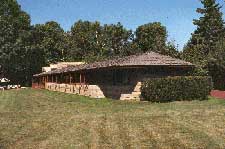
7111 North Barnett Lane
Fox Point
Landmark Designation: 1977
Frank Lloyd Wright designed and personally supervised the construction of this home for Milwaukee businessman Albert Adelman in 1946. Although the house’s long, low profile recalls Wright’s turn-of-the-century “prairie” homes, it also embodies Wright’s ideals for low-maintenance buildings. It is built of concrete block and cypress, neither of which requires paint or plaster. The roof is covered with cedar shakes. Wright also designed many of the interior furnishings. The Adelman House is situated at the end of a long, winding drive, and a curious passerby must be content with only a glimpse of the modernistic, Wright-designed mailbox.
Brooks Stevens House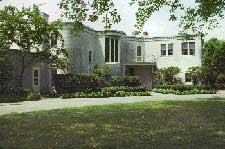
8041 North Gray Log Lane
Fox Point
Landmark Designation: 1981
Built in 1939, this unique two-story home is based on the “form follows function” concept with living areas in one wing and service areas in another. Its Y-shaped floor plan allows increased exposure of its rooms to exterior light and ventilation. The house has a flat roof, cement walls and aluminum windows, flashings, cornices and expansion joints. Designed by Fitzhugh Scott for industrial designer Brook Stevens, the style is indicative of the Art Deco architecture popular at the time of its construction.
Old Dutch Schoolhouse Site and Burial Ground
8400 North Fox Lane
Fox Point
Landmark Established: 1991
The Old Dutch Schoolhouse is a hewn-log schoolhouse that was erected in the winter of 1853-54 by School District
No. 9 in the Township of Milwaukee. The structure was also used for public meetings as well as for church services by the Reformed Church of Bethlehem, a Dutch Reformed Congregation. In 1868, the adjoining tract was deeded to the congregation for cemetery purposes, although grave markers indicate that burials had taken place as early as 1854.
Bus Stop Shelters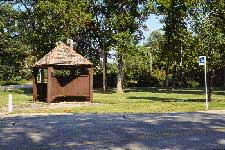
Along North Lake Drive
Fox Point
Landmark Established: 1994
The bus waiting station on the southwest corner of the intersection of East Bell Road and North Lake Drive is one of four on Lake Drive in Fox Point. It is located along a major thoroughfare by which residents and visitors come to Fox Point, offering close proximity to the village’s civic center. It is also close to a small area of commercial buildings which were designed to harmonize well with the adjacent residential community. It is situated on one of the 45 green spaces owned and maintained by the Village of Fox Point.
The Bell Road bus station was built in 1940 along with one at Bradley Road at the direction of the Fox Point Park Commission at the cost of $250 each. It was selected for landmark designation for its uniqueness, and for the fact that preserving history includes preserving the essential marks of community character.
The Bell Station, as well as the other three shelters in Fox Point, were an amenity for the use of both the general public and community residents. The three other stations are: on the southwest corner of Lake Drive at Green Tree (1937); on the southwest corner of Lake Drive at Bradley Road (1940); and on the southeast corner of Lake Drive at Dean Road (1963). They were built to “blend in” with a green, residential community, one that was described in the early 1920s in a Calumet Land Company advertisement as “one large, beautiful park.”
When repairs needed to be made, Fox Point Village officials chose to use a more expensive re-roofing method in order to preserve the quality and character of the shelter, thus honoring these “monuments” as “living” representatives of the quality and character of the community, not a façade or shell easily replaced for usability.
Cast Iron Street Signs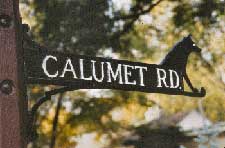
Fox Point
Landmark Established: 2002
The original cast iron signs were first installed in the 1930s following incorporation of the Village of Fox Point in 1926. Black with white lettering, the fox image is displayed overlooking the streets of the village. These signs are excellent examples of the way streetscapes contributed to local identity and how the rising automobile culture influenced urban art.
Friedlander Residence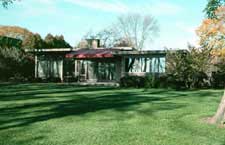
6970 N. Barnett Lane
Fox Point
Landmark Designation: 2006
Constructed in 1952 with the full participation of the current owners, the Friedlander Residence was designed by local architects Willis and Lillian Leenhouts. Lillian Leenhouts was the first woman licensed to practice architecture in Wisconsin. The Friedlander residence is typical of the simple, unpretentious ranch houses the couple designed in Milwaukee, Whitefish Bay, Glendale, Fox Point and other local communities. Oriented toward the south to take advantage of solar heat and available daylight, equipped with myriad built-ins, and sensitive to its site, the Friedlander Residence typifies the Leenhouts philosophy and remains almost unchanged from its original design. The property was designated for its architectural significance.
Mary Nohl House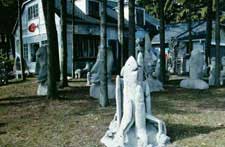
7328 N. Beach Drive
Fox Point
Landmark Designation: 2006
Built around an early beach cottage originally constructed in 1921, the Nohl family residence was converted into a year-round house in the 1940s with the construction of a two-story addition. In the 1960s, following the death of her father, artist Mary Nohl began transforming the house and the lot surrounding it into a total art environment. Over sixty sculptures of concrete, glass and stone populate the yard, including a grinning twelve-foot dinosaur. Colorful panels of creatures and figures in profile adorn virtually every surface of the home’s exterior, while the interior contains thousands of works from a lifetime of tireless experimentation with virtually every media. Mary Nohl was one of only a very few women ever to undertake such a total artistic transformation of her personal world. The property was designated for its architectural and historic significance.







